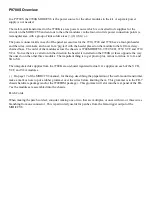
OM-7986
Page 8 of 23
Issue A - Rev 8
To release the LRT, simultaneously press and hold down for >1 seconds the PROGRAM and
BATTERY/LOAD buttons. ‘
EnbL
’ will be displayed indicating the transponder will be enabled.
The first unique release command will then be sent to the transponder. If the transponder
receives the command it will reply and the range in metres will be displayed and a beep heard.
The operator then has 20 seconds time limit within which to send to the second release
command to the transponder. Again simultaneously press and hold down for >1 seconds the
PROGRAM and BATTERY/LOAD buttons. ‘
Set
’ will be display indicating the release
mechanism will be set. The second release command will be sent, again the transponder will
reply and the range will be displayed.
The surface unit then automatically sends a third unique release command to confirm the
release action, ‘
rEL-
’ will be displayed and then the range in metres. The surface unit then
displays ‘
-run
’ indicating that the release mechanism is turning, it takes approximately 30
seconds for the nut to be released, the surface will display ‘
donE
’ to indicate the release is
complete.
With all three of the above commands sent, if no reply is received from the LRT then the
surface unit will display ‘
FAIL
’. If the final ‘
rEL-
‘ command results in a ‘
FAIL
’ the timer will still
run but will display ‘
----
‘. It is permissible in this circumstance to again press and hold down
the PROGRAM and BATTERY/LOAD buttons to repeat the ‘
Set-
‘ ‘
rEL-
‘ sequence.
NOTE
– Due to acoustic ambient noise at the surface, typically generated by the vessel, the
reply signal from the LRT to the surface is more difficult to detect than the down going
release command to LRT on the seabed. This therefore means that in difficult environments
although the reply signal from the transponder is not received (No Reply) the transponder
may have heard the release command and will therefore release. If No Reply is indicated it is
therefore still worth while continuously transmitting the release command to recover the LRT.
Whilst in the
‘–run’
mode the surface unit will not allow any other commands. However the
surface can be reset in this mode by switching to the ‘RS232’ position and back again to the
selected address. By pressing the TEST/RANGE button it is then possible to range to the
LRT. As the range starts to decrease this will indicate that the LRT is rising to the surface.
Recover the LRT from the water and ensure that nut has been released from the mechanism.
Note that if testing in very shallow water the acoustic performance may be poor, due to the
acoustically reverberant environment. If so, try re-testing in deeper, more open waters.










































